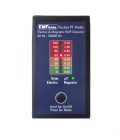
EMFs are easy to measure and the information supplied with the instruments helps you identify whether the EMF levels in your home are associated with health risks. These are described in "Powerfrequency EMFs and Health" - freely available from the info/article section of the EMFields website.
The EMFields PF5 pocket power frequency meter measures both electric and magnetic fields (click image on the right for more details)
Hold the chosen meter in one hand, with your fingers at the back and your thumb at the front at the bottom of the meter. Wait till the figures settle and that is your reading. When measuring magnetic fields, the highest reading could be when you a) hold the meter vertically b) hold it with the back facing the ground c) hold it with the side facing the ground. All these readings are genuine, because of the characteristics of magnetic fields. Use the highest reading as your measurement.
Powerlines
As a rough guideline, the bigger the pylon, the higher the electromagnetic field levels (EMFs) are likely to be. The pylons themselves do not give off EMFs as the cables are insulated from the structures. The cables give off electric and magnetic fields. Standing under the highest wire (the middle one for high voltage lines) will give the highest reading.
EMFs from powerlines drop as you go away from the line. EMFs from high voltage lines take longer to fall to background levels than low voltage lines, so the further away you have to be for the levels from the cables to be undetectable. It is difficult to know for sure how far away you have to be, as the electricity flow down the two sides of high voltage lines may be different causing unbalanced EMFs which take longer to go away.
Transformers can be found at the end of rural lines, a grey box on a pole. The EMFs from these are unlikely to to be a problem, unless there is one close to a house.
Substations
Substations are very common. The larger the area that they supply electricity to, the larger will be the substation. Most small substations will be no problem as the fields fall away quickly. Larger ones can create high EMFs especially in houses very close to them.
There are underground cables coming from substations to properties nearby. Immediately above these cables the EMFs are high. They fall rapidly as you move away from the cables. If a cable goes close to your house or garden, you may get high fields nearby.
Sometimes substations are connected in a way that gives 'net' currents which do not reduce very quickly. These are surprisingly common and unpredictable. If your property is in between substations creating a net current, you may find high fields throughout the ground floor.

